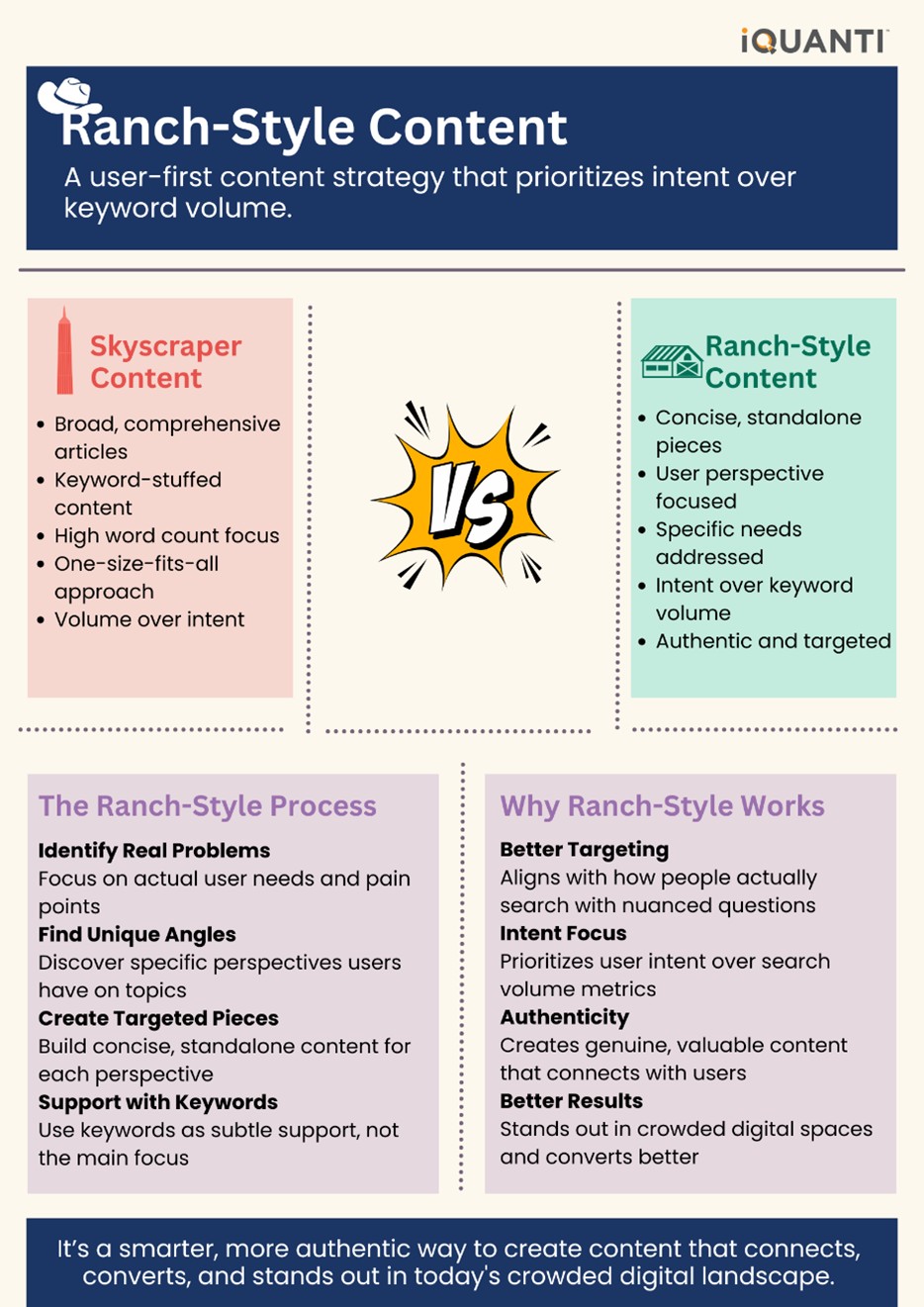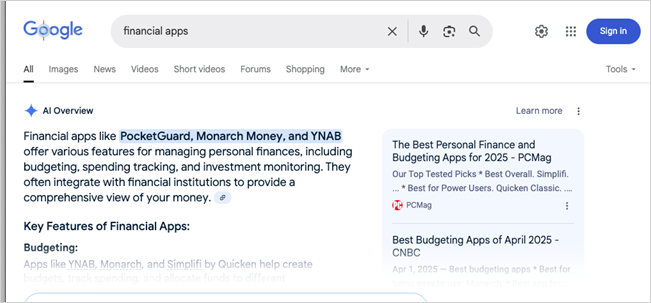Lisa Dolbear, Director of Content at iQuanti, shares her thoughts on ranch-style content and how it prioritizes intent over keyword volume.
Cinch up your saddle and slide into your stirrups, because we’re about to take a ride into the wild west of content strategy to explore the benefits of ranch-style content, and the importance of focusing on the user.
With user intent evolving and generative AI reshaping search, sprawling skyscraper articles aren’t always what users—or Google—want anymore. That’s where ranch-style content comes in.

What Is Ranch-Style Content?
Ranch-style content is the comparative play on words to skyscraper content. The latter is a term used to describe a comprehensive article that touches on all points of the user journey, considering user intent in content creation, from information that might be sought after in the discovery phase, to details that nurture the user through the consideration phase, all the way to the point of transaction. These pieces generally boast high word counts and robust coverage of a single topic, and were once regarded as a sound strategy for creating content.
By contrast, SEO expert and founder at Clearscope, Bernard Huang, describes ranch-style content as a strategy that “disaggregates mega guides” in favor of creating standalone pieces on each unique piece of the journey to better satisfy user intent in content creation and signal to Google that the content is relevant and high quality. In a recent webinar sponsored by Moz, Huang stated “it’s not as much about targeting keywords, it’s targeting how somebody is wanting to do research for that given topic in a relatable and authentic manner.”
The ranch then, is not as tall as the skyscraper, as it does not centralize all of its purposes within a single building. Rather, the ranch is spread out to cover a lot of ground using a variety of buildings with different functions. A barn to shelter horses, a prairie to raise cattle, and a lavish home—maybe even the kind where Beth Dutton might throw a whiskey glass at the wall.
Why Is Ranch-Style Content Important for SEO and User Intent?
At the heart of great content strategy is demonstrating an understanding of the user, and creating content for user intent. Ranch-style content forces you to put the user first when developing a content strategy and deciding what to write about. It provides undeniable guard rails that help content strategists stay efficient with their topic ideation and content planning.
Ranch-style SEO is crucial because it aligns with how users actually search—they don’t follow a linear path but rather explore different aspects of a topic across multiple searches, making comprehensive, interconnected content essential for capturing traffic at various stages of their journey.
When I am building a content strategy, I always reference Google’s research on purchase behavior and decision-making, which is based on “the messy middle” infinity loop where a user toggles back and forth between exploration and evaluation before arriving at a purchase decision.
Good content strategy is about understanding the triggers that land the user in this journey, and figuring out what kind of content can help them move efficiently through the loop with less friction. Understanding the triggers can help us understand where on the ranch we need the user to go, in order to accomplish their goals. Triggers help us frame the perspective our user might have on a topic.

Image source: Think with Google
Topic Ideation in Ranch-Style Content
One of the most powerful benefits of ranch-style content is that it forces you to think about topics from a deep and skim-able perspective. It goes beyond traditional hub and spoke frameworks where you create a pillar page on a main topic, then spin out supporting pages with subtopics. Ranch-style content requires you to think of each subtopic as the main topic – and to drill down to different perspectives a user could have on that topic.
Let’s bring this to life with a real-world example.
Lucy is a college student looking for ways to manage her finances and stick to a budget. She’s aware there are a lot of apps that can help her visualize how she’s spending her money, and provide insight on gaps and opportunities in her financial behavior. So Lucy isn’t likely to use a query like, “financial app,” because she knows what they are, and it doesn’t get to the root of her problem. But if she did use that query, it would pull up an AIO which doesn’t do much to help her understand whether or not this is a good idea for her.

Now let’s look at a query that Lucy might use if the AIO wasn’t helpful and she wanted to get a better result (and she isn’t alone – a recent study by Semrush found that 30% of people are either refining or extending their searches in some way when they use Google):
Ex: Are financial apps okay for college students
SERP Results With Conversational Queries
As you can see from these search results, now Lucy is getting some high-quality recommendations to help her solve her problem, including links to forums and Reddit that offer real-world experiences, relevant PAAs, and super specific SERPs that align with her problem.
Each of these perspectives helps uncover a specific user intent in content creation—and that’s exactly what Google is rewarding.
Other examples of how to re-think “financial app” using different perspectives:
- What does a financial app work best for
- Biggest reasons NOT to use a financial app
- Can anyone get a financial app
Each example offers a very clear focus area to outline for a piece of content. Whereas a “skyscraper” article might influence a writer to pull together too many ideas at once, get too into the weeds about a topic, or include too many keywords (thus overwhelming the reader and underwhelming Google), a ranch-style article will be laser-focused on a specific need and concisely written.
The Role of Keywords in Ranch-Style Content
While Google’s current algorithms are clearly focused on rewarding content that is authentic, relevant and original, keywords still play a role in ranking. Think of keywords like garnish in ranch-style SEO – they should be strategically placed to help bolster the flavor coming out of your content. They should be present, but not obvious. They should support, but not stifle. In ranch-style content, keywords follow the user—not the other way around.
Unlike in traditional SEO, keyword research should not start with analyzing search volumes, but with understanding the user, the topics that fit best with that user, and then finally the keywords that align with those topics and their various perspectives. Don’t be surprised if your research uncovers more specific, lower-volume phrases. That’s a sign you’re truly aligning with user intent. Just as you’re likely to find longhorns on a ranch; you’re likely to find long-tail keywords in ranch-style content.
Ranch-Style Round Up
There are many resources to explore if you want to dive deeper into ranch-style content and all of its elements and frameworks, but the prize pony from my perspective is the efficiency with which you can understand the things that matter most to the user. Content strategy is a huge task that can seem daunting when you consider all the areas we must focus on before our ideas even get to the production stage. Wouldn’t it be nice to know that you’ve set the strongest possible foundation for that content creation by ensuring what you write about will reach your audience and help them take the next step?
Ranch-style content isn’t just a clever metaphor—it’s a mindset shift. It prioritizes real user needs over search engine tricks. In a world where users are savvier and SERPs are noisier, this approach helps you include user intent in content creation, resulting in content that’s not only found, but actually felt.
At iQuanti we are continuing to focus on evolving our AI-driven solutions to help ensure we are meeting users where they are, and providing them with what they need through a robust eco-system of content based on user-centric insights and strategies.
To know more about our services, get in touch.







